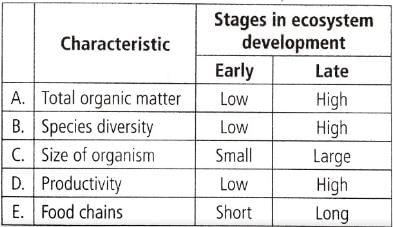Test: Ecological Succession (NCERT) - NEET MCQ
10 Questions MCQ Test - Test: Ecological Succession (NCERT)
Match column I with column II and select the correct option from the given codes.


In lithosere, foliose lichens make the conditions favourable for the growth of
Select the correct sequence of succession in a pond
Correct sequence of stages of succession on a bare rock is
Read the given statements and select the correct option.
Statement 1: Pioneer community is the stable and final biotic community of an ecological succession.
Statement 2: Pioneer community has maximum diversity and niche specialisation.
In the given figure, A,B,C,D,E and F represent some stages of hydrosere. Select the correct statement regarding these.

An ecosystem which can be easily damaged but can recover after some time if damaging effect stops will be having
During the stages of succession in a given ecosystem, the following changes in characteristics may be observed.

Which one of the characteristics A,B,C,D or E is responsible for the apparent high degree of stability associated with a climax ecosystem?
Second stage of hydrosere is occupied by plants like



















